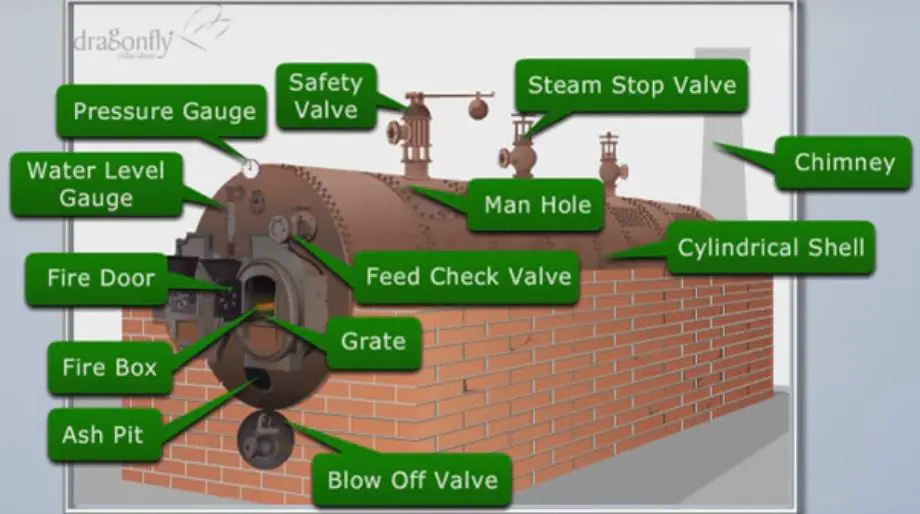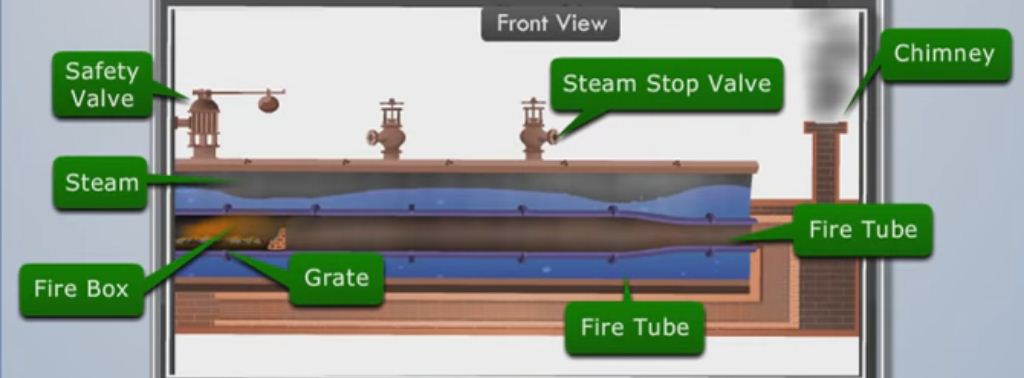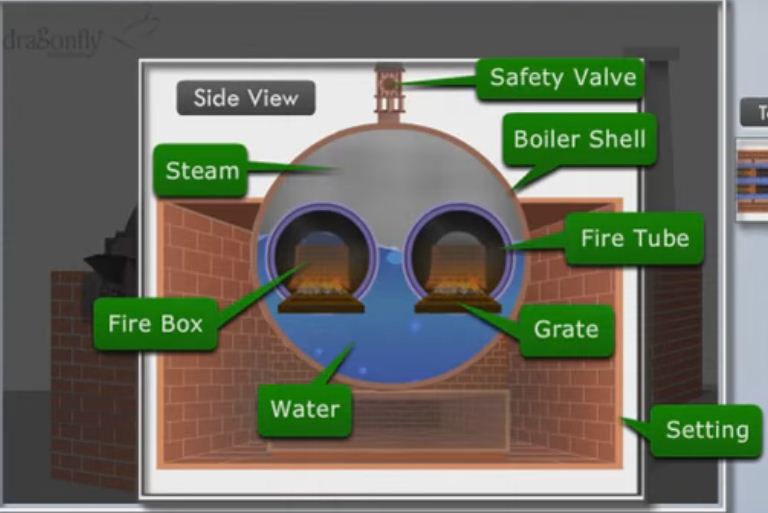A lancashire boiler is a horizontal drum axis, natural circulation, natural draft, two-tubular, low pressure, stationary, fire tube boiler with a furnace located internally. Its main purpose is to create steam and then this steam is used to drive steam turbines for power generation. It has high thermal efficiency and it is about 80 to 90 percent. It is mostly used in locomotive engines and marines etc.
Main Parts of Lancashire Boiler
The various mounting of this boiler are as follows

| Name | Function |
| 1. Safety Valve | Used to Blow off extra steam when working pressure Exceeds |
| 2. Water Level Indicator | Indicates the level of water in the boiler |
| 3. Pressure Gauge | Indicates the Pressure of Steam inside the boiler |
| 4. Steam Stop Valve | Stops and allows steam from the boiler |
| 5. Feed Check Valve | Allows and stops the flow of water in the boiler |
| 6. Blow off Valve | Removes sediments and mud periodically |
| 7. Manhole | An opening to enter in boiler for cleaning and maintenance |
| 8. Fusible Plug | extinguishes fire inside the boiler when water level drops below safety level |
| 9. Grate | platform for solide fuel to burn |
| 10. Fire Door | Door for the ignition of fuel |
| 11. Ash Pit | A pit to collect ash of burnt fuel |
1. Safety Valve:
It is used to blow off the steam when the pressure of the steam inside the boiler exceeds the working pressure.
2. Water Level Indicator:
It indicates the level of water in the boiler. It is placed in front of the boiler. Two water level indicators are used in the boiler.
3. Pressure gauge:
The function of the pressure gauge is to indicate the pressure of the steam inside the boiler.
4. Steam stop valve:
Its function is to stop and allows the flow of steam from the boiler to the steam pipe.
5. Feed check valve:
It stops and allows the flow of water inside the boiler.
6. Blow off Valve:
Its function is to remove the sediments or mud periodically that is collected at the bottom of the boiler.
7. Manhole:
It is a hole provided on the boiler so that a man can easily enter inside the boiler for the cleaning and repairing purpose.
8. Fusible plug:
It is used to extinguish the fire inside the boiler when the water level inside the boiler falls to an unsafe level and prevents an explosion. It also prevents the damage that may happen due to the explosion.
9. Grate:
It is a platform that is used to burn solid fuel.
10. Fire door:
It is used to ignite the fuel present inside or outside the boiler.
11. Ash pit:
It is used to collect the ash of the fuel after the fuel is burnt.
Accessories Used in the Lancashire Boiler
1. Economizer:
It is a mechanical device which is used as a heat exchanger in a steam power plant. It is used to pre-heat the fluid or water by taking the residual heat from the combustion products i.e. flue gases. it is just installed to increase the efficiency of the boiler in the power plant.
2. Air pre-Heaters:
It is a mechanical device that abstracts the heat from the flue gases and transfers it to the air. In boilers, the pre-heaters are installed in between the economizer and the chimney.
3. Superheater:
It is used in the superheating of steam produced in the boiler. Its main purpose is to increase the temperature of the saturated steam without any change in the pressure.
4. Feed pump:
It is used to pump the water from storage to the boiler during the boiler operation.
Also Read:
- Cochran Boiler – Main Parts, Working, Advantages and Disadvantages
- Locomotive Boiler – Construction Working and Application with Diagram
- What is a Boiler? Different Types of Boiler
Lancashire Boiler Working


Now I am going to explain the working of this boiler step by step:
- Lancashire boiler consists of a horizontal cylindrical shell filled with water surrounding two large fire tubes.
- The cylindrical shell is placed over brickwork which creates several channels for the flow of hot flue gases.
- Solid fuel is provided by the fire door which then burnt over grate at the front end of each fire tube.
- A small arc shape brickwork is provided at the end of the grate to deflect the flue gases upward and prevent the entry of burning coal and ashes into the interior part of the fire tubes.
- The fire tubes are slightly conical at the rear end to increase the velocity of hot flue gases.
- When hot flue gases are allowed to pass through the downward channel at the front end of the fire tubes. Now, these gases pass through the side channel towards the rear end of the fire tube and finally escape out through the chimney.
- There are dampers at each side channel to regulate the airflow.
- The feed check valve is used to feed the water uniformly to the boiler shell.
- Once the boiler is at quickly, water converts into steam by absorbing the heat from the flue gases. This steam is stored at the upper portion of the boiler where the anti priming pipe separates the water from steam. Thus the steam stop valve receives the dry steam for various purposes.
- A manhole is provided at the top and bottom of the shell to allow a man to enter into the boiler and clean it.
- A blow-off valve is provided to remove the mud that has settled down. It is also used to clean the boiler.
For a better understanding watch the video given below:
Advantages
- It has high thermal efficiency; the thermal efficiency is about 80 to 90%.
- It is easy to operate.
- It can easily meet the load requirement.
- Easy to maintain.
- Generate a large amount of steam and hence more reliable.
- Low consumption of electricity due to natural circulation.
Disadvantages
- It is a low-pressure type boiler, so high-pressure steam is not produced.
- Tedious maintenance of brickwork.
- It has a limited grate area due to the small diameter of the flue tubes.
- The steam production rate is low. It is about 9000 kg/hr
- Corrosion occurs in the water legs.
Area of Application
The Lancashire boiler is used to drive steam turbines, locomotives, marines, etc. it is used in industries like paper industries, textile industries, sugar industries, tire industries, and Etc.
Now this is all about the Lancashire boiler. If you find anything missing in this then let me know through your commenting.
